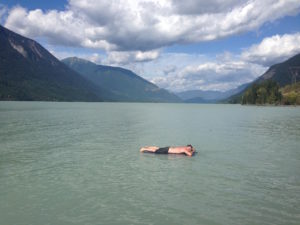Working in the heat? Floating on a lake? Packing your car for a road trip? Please read and share these summer safety tips and enjoy the season.

Summer at Lillooet Lake, B.C.
Photo credit: Susan Main
It’s official as of June 20: Summer has arrived! I’m planning to enjoy it and hope you are, too. Here are some summer safety tips I collected from the web to keep in mind. Please share this post with your contacts and leave a comment if there are other tips you’d like to add.
On the water
Tips from Backyard Pools, by the Canadian Red Cross:
- Never leave your child unattended, not even for a second.
- Keep the deck clear of toys and debris.
- Build a fence that has a self-closing and self-latching gate; keep the gate closed with restricted access at all times.
Tips from Lightning Safety on the Water, by Environment and Climate Change Canada:
- If you are on or in the water, get to land as quickly as possible at the first sign of a storm.
- Once ashore, seek a safe location either in a building with wiring and plumbing or in an all-metal vehicle (not convertible top).
- If caught outside far from a safe location, stay away from tall objects, such as trees, poles, wires, and fences. Take shelter in a low-lying area.
On the road
Tips from Keys to Smart Car Packing: How to safely load your car for a road trip by Consumer Reports include:
- Put the heaviest items up front, towards the centre of the vehicle.
- Secure loose items.
- Keep essentials like your roadside emergency kit handy and readily accessible.
Motorcycle Safety by the Insurance Corporation of B.C. includes these tips for sharing the road safely with motorcyclists:
- Allow at least three or four seconds of following distance when behind a motorcycle and plenty of lane space when you pass.
- Be ready to yield, as a motorcycle is often closer than it seems. Remember, it can be hard to tell how fast a motorcycle is travelling.
- Scan intersections carefully and take an extra moment to look for motorcycles when you’re turning left.
Pets in Hot Cars by the BC SPCA reminds us not to leave pets in cars during hot weather — not even in the shade, or with the windows partly open, or with the air conditioning on. It also says what to do if you see a pet in a car and believe it may be in trouble:
- Ask nearby stores to page the pet’s human.
- If the pet is showing symptoms of heatstroke (detailed in the article) or medical distress, call 9-1-1.
In nature
Tips from Camping Safety, by the BC Safety Authority, on avoiding carbon monoxide poisoning:
- Leave all camping appliances (like camping stoves, space heaters, and barbeques) outside of enclosed spaces.
- Know the symptoms of CO poisoning — nausea, headache, dizziness, confusion, and unconsciousness.
- Bring extra clothes, blankets, flashlights, and batteries so that in case of an emergency you aren’t tempted to bring fuelled appliances inside when it’s cold or dark.
Tips from Avoid Getting Lost by North Shore Rescue include:
- Be prepared for your chosen hike.
- Never hike alone.
- Leave information about your destination, route, and return time with a friend. If you do not return as planned, this person can give the accurate information to the police.
At work outside
Preventing Heat Stress At Work by WorkSafeBC outlines employers’ duty to assess and plan for workers’ safety in the heat. This includes many things, such as:
- Schedule the hardest physical tasks for the coolest part of the day.
- Allow for slower-paced work during the hottest part of the day.
- Do not allow workers to work alone in conditions where heat stress is possible.
Anything you’d like to add?


